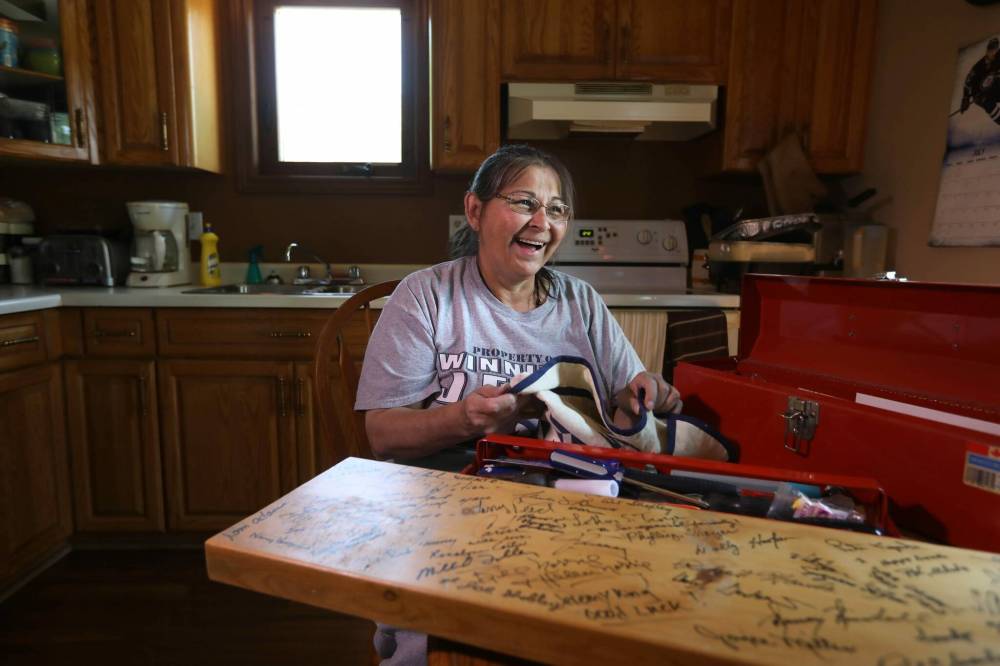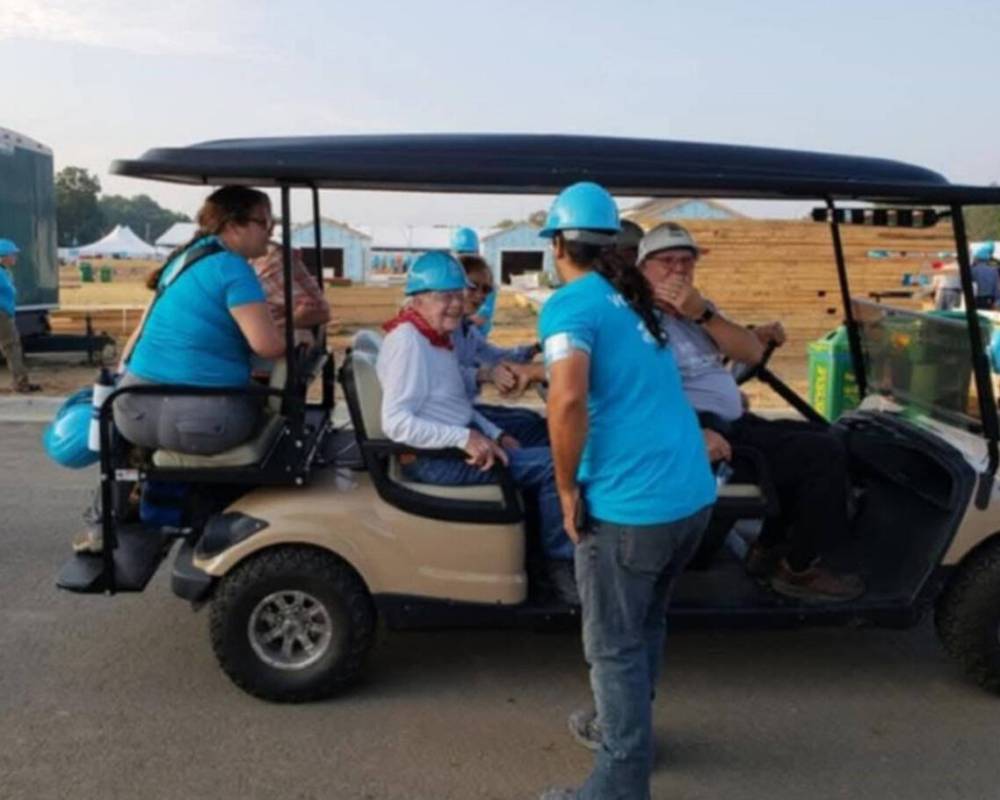When visitors walk into Cheryl Pelletier’s house, the first thing they’ll probably notice is a large framed photo, featuring the Winnipeg woman’s family and Jimmy and Rosalynn Carter, hanging proudly on a wall.
It’s one of the keepsakes Pelletier has displayed since the former U.S. president and first lady helped build her Habitat for Humanity home in July 1993.
“It was all work that day,” said Pelletier, who reflected on her brief time with the couple in the wake of Jimmy Carter’s death Sunday. “He was a really nice person, and I really liked him and his wife. They were like normal people.”

RUTH BONNEVILLE / FREE PRESS FILES
Cheryl Pelletier sits at her kitchen table in 2017 with a board signed by Jimmy Carter and the crew working on her house
Carter, a Democratic president from 1977 to 1981, died peacefully while surrounded by family at his home in Plains, Ga., the Carter Center said. He was 100 years old. Rosalynn Carter died at 96 in November 2023.
The Carters twice visited Winnipeg to work on and promote Habitat for Humanity projects as part of their worldwide humanitarian efforts.
When they returned in July 2017, Jimmy Carter spent a night in hospital as a precaution after he became dehydrated while working on a housing project in St. James.
In 1993, Pelletier and the Carters shook hands and chatted for a few minutes before getting to work with fellow volunteers.
Jimmy Carter helped install the kitchen sink in the North End home that she still lives in. He also made a cutting board for her.
“I got a hug from both of them. It was really nice,” Pelletier said of the Carters. “I always thought he was real cool to be doing everything he was doing.”
She said it was a surreal experience, due to the couple’s notoriety and the presence of Secret Service agents who accompanied them.
Before everyone put down their tools that day, Pelletier and her two children posed for a photo with the Carters and the rest of the crew outside their house on Habitat Place.
RUTH BONNEVILLE / FREE PRESS FILES
A copy of a group photo of all the crew that worked on Cheryl Pelletier’s home.
The photo is next to a plank of wood that was signed by the Carters and other workers. Pelletier’s son is sitting on Jimmy Carter’s lap in the picture.
Workers built 18 homes in the city during the first international Jimmy and Rosalynn Carter Work Project that summer.
More than 30 years later, Pelletier’s television happened to be switched to CNN when Carter’s death was announced in a breaking news report Sunday.
“I got up and I looked, and I was like, ‘Oh my God. Jimmy — he’s gone,’” she said. “My heart is with his family.”
The Carters made a second visit to Winnipeg in 2017 for the 34th Carter Work Project, which had a goal of building 150 homes across the country to celebrate Canada’s 150th anniversary.
The campaign included 16 homes on Lyle Street, near Deer Lodge Community Centre, on the site of a former police station.
Jimmy Carter helped build the wooden front steps that lead to a house that became home for Todd Gauthier and his two daughters.
Gauthier, who still lives in the house, spent a few minutes talking to the Carters before everyone got to work sawing boards and doing other tasks.
RUTH BONNEVILLE / FREE PRESS
A photo of Cheryl Pelletier’s board which has the signatures of everyone who worked on the house – including Jimmy Carter and his wife Cheryl Pelletier.
“They really were generous people. They dedicated so much of their retired life to seek out and help people,” he said Monday.
His daughters made cards for the Carters that summer to thank them for their efforts. It was during that build that Carter became dehydrated and was taken to St. Boniface Hospital.
He encouraged everyone to keep working and stay hydrated before he left the build site. Then 92, he returned the next morning, after an overnight stay in hospital for observation.
Carter later told the Free Press he’d been working too hard in the heat. He touched on the need to build more affordable homes and close the income inequality gap.
“Just building houses, just hammering a nail or putting in a screw, or sawing a board — in a way, that is our small contribution, I think, to human rights,” he said.
Before he was hospitalized, the devout Christian delivered a morning devotion in which he told volunteers that discovering Habitat for Humanity in 1984 “gave me the best opportunity I had… to break down the barriers between people like myself, that had everything I ever wanted, and people in need of a decent home.”
A few months later, Carter told college students in Atlanta that he supported a single-payer health-care system, a view possibly reinforced by his time in a Winnipeg hospital, the Canadian Press reported at the time.
He recounted how, when he was released from hospital, he asked what he owed and was told “zero,” adding “the Canadian taxpayers paid for my treatment.”

SUPPLIED
Todd Gauthier met Jimmy and Rosalynn Carter when they worked on his Habitat for Humanity home in St. James in 2017.
Theoretically, single-payer is “the best system,” he told the students.
In the summer of 2018, a year after the Carters worked on his home, Gauthier travelled to South Bend, Ind., to help build houses for the 35th Carter Work Project.
It’s something he would like to do again, if the opportunity arises, to honour the Carters, who were a “shining example” of living a godly life for others, he said.
“It was very sad,” Gauthier said of Jimmy Carter’s death. “I feel the Earth lost one of its true heartfelt people out there.”
chris.kitching@freepress.mb.ca

Chris Kitching
Reporter
Chris Kitching is a general assignment reporter at the Free Press. He began his newspaper career in 2001, with stops in Winnipeg, Toronto and London, England, along the way. After returning to Winnipeg, he joined the Free Press in 2021, and now covers a little bit of everything for the newspaper. Read more about Chris.
Every piece of reporting Chris produces is reviewed by an editing team before it is posted online or published in print — part of the Free Press‘s tradition, since 1872, of producing reliable independent journalism. Read more about Free Press’s history and mandate, and learn how our newsroom operates.
Our newsroom depends on a growing audience of readers to power our journalism. If you are not a paid reader, please consider becoming a subscriber.
Our newsroom depends on its audience of readers to power our journalism. Thank you for your support.